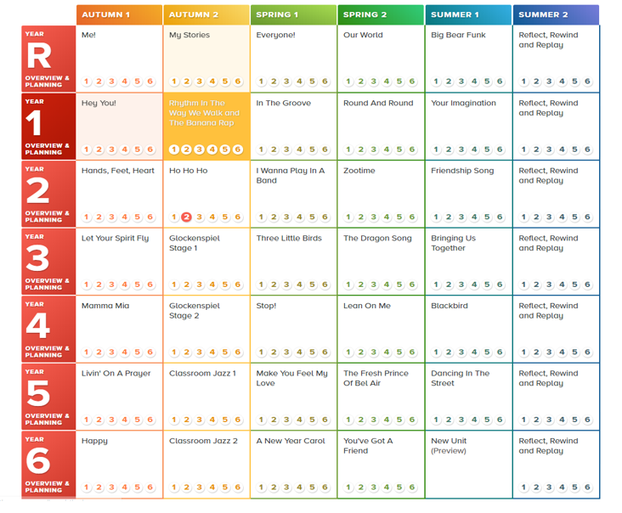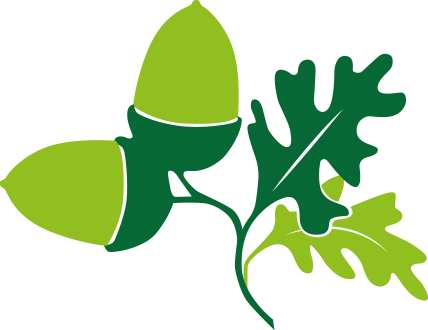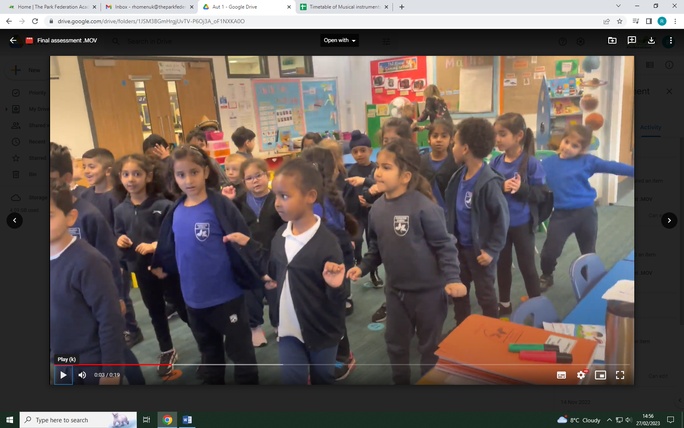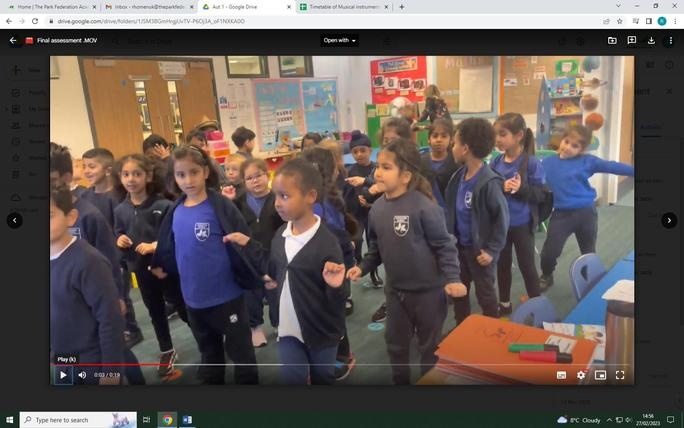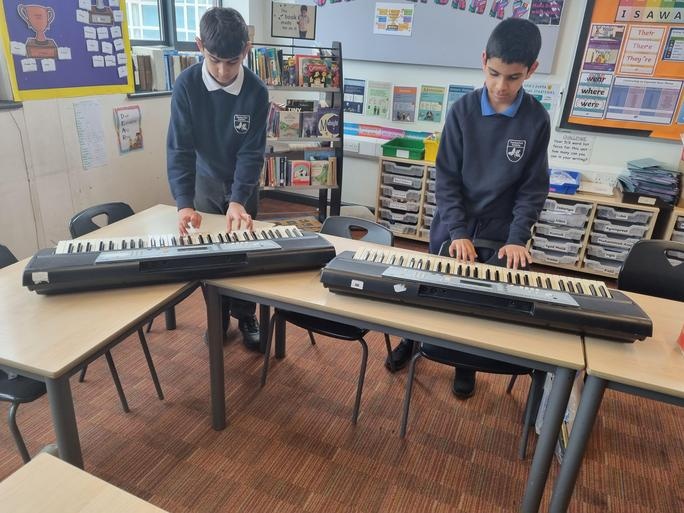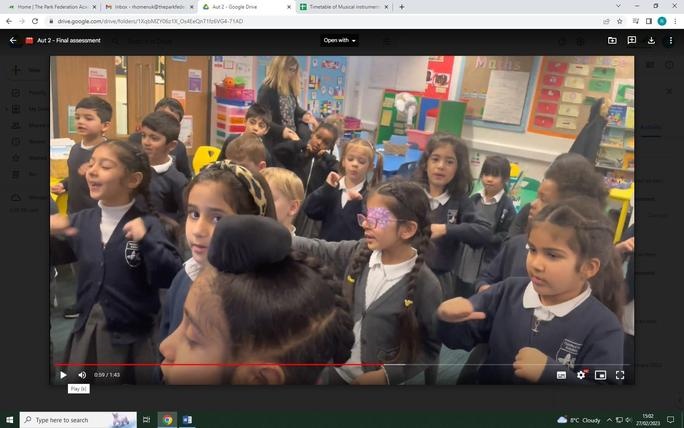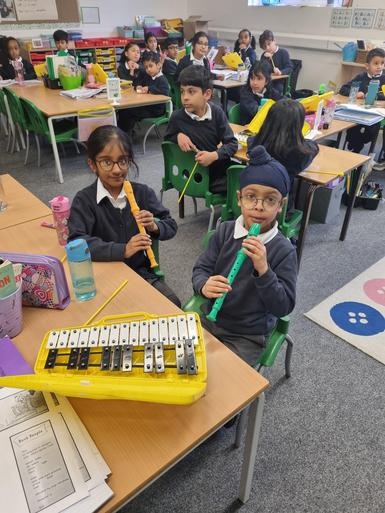Music
Music Curriculum Statement
1. Music Statement
Intent
Music is a universal language that embodies one of the highest forms of creativity. A high quality music education should engage and inspire children to develop a love of music and their talent as musicians, and so increase their self-confidence, creativity and sense of achievement. As children progress, they should develop a critical engagement with music, allowing them to compose, and to listen with discrimination to the best in the musical canon.
Aims
The national curriculum for music aims to ensure that all children:
- perform, listen to, review and evaluate music across a range of historical periods, genres, styles and
- traditions, including the works of the great composers and musicians
- learn to sing and to use their voices, to create and compose music on their own and with others,
- have the opportunity to learn a musical instrument, use technology appropriately and have the
- opportunity to progress to the next level of musical excellence
- understand and explore how music is created, produced and communicated, including through the
- interrelated dimensions: pitch, duration, dynamics, tempo, timbre, texture, structure and appropriate musical notations.
At Cranford Park Academy, the intention is that children gain a firm understanding of what music is through listening, singing, playing, evaluating, analysing, and composing across a wide variety of historical periods, styles, traditions, and musical genres. Our objective at Cranford Park Academy is to develop a curiosity for the subject, as well as an understanding and acceptance of the validity and importance of all types of music, and an unbiased respect for the role that music may wish to be expressed in any person’s life. We are committed to ensuring children understand the value and importance of music in the wider community, and are able to use their musical skills, knowledge, and experiences to involve themselves in music, in a variety of different contexts.
Implementation
The music curriculum ensures children sing, listen, play, perform and evaluate. This is embedded using the ‘Charanga Music School’ scheme of work weekly. The elements of music are taught in classroom lessons so that children are able to use some of the language of music to dissect it, understand how it is made, played, appreciated and analysed. In the classroom, students learn how to play the glockenspiel, recorders and a variety of percussion instruments. They also learn how to compose focusing on different dimensions of music, which in turn feeds their understanding when listening, playing, or analysing music.
Impact
Whilst in school, children have access to the ‘Charanga Music School’ scheme of work, which allows students to discover areas of strength, as well as areas they might like to improve upon. Children are able to enjoy music, in as many ways as they choose - either as listener, creator or performer. They can dissect music and comprehend its parts. They can sing and feel a pulse an gain an understanding of how to further develop skills less known to them, should they ever develop an interest in their lives.
2. Teaching and learning policy and framework
Fundamental skills and knowledge are taught to children through the ‘Charanga Music School’ scheme of work. All children gain a simple understanding of musical notation, playing an instrument, composition, listening and analysing music. Teaching is activity based. Lessons across the school are delivered by the class teacher in Reception through to Year 6.
All children from, Years R-6, learn to play the glockenspiel and a variety of percussion instruments. Children are given the opportunity to learn a variety of instruments on an individual basis in lessons delivered by peripatetic teachers and paid for by parents. Children also have the opportunity to sing in the school choir and perform to the local community.
3. Assessment
The teacher will informally assess throughout any creation or rehearsal process, giving oral feedback, and instant methods of ways to improve. Pupils are also assessed individually when performing, as ensemble playing is evidence of achievement. The evidence is in the critical listening of each child, and the audience. Children are encouraged to make judgements about how they may improve their work. Their performances are recorded electronically and saved to a music evidence file on the computer hard drive.
4. Planning and Resources
Planning and the resources needed for each lesson is the responsibility of the class teacher. However, the plans are all available for each year group on the ‘Charanga’ website. For termly singing assemblies, the content, musical accompaniment and any teaching is the responsibility of the class teacher. Resources are the responsibility of the class teacher. Planning for peripatetic music lessons is the responsibility of each peripatetic teacher. Resources are provided by the school but organised by the music leads.
5. Organisation (e.g. blocks or weekly lesson)
Music lessons are taught weekly and are one hour in length for KS1 and KS2. For Reception, the lessons are half an hour long. Students who wish can apply to learn keyboard, guitar and violin. These lessons are weekly, and are on an individual basis. There is an after school choir that children may take part in.
6. EYFS
Music for EYFS children has a primary focus on singing and movement, developing the student’s listening abilities, physical co-ordination, inner/outer ears, motor-neuron skills, memory, aural awareness, and singing skills. Therefore, music plays an important part in a child’s early development.
The Early Years
Foundation Stage curriculum encompasses all areas of creative development, particularly in the area of Expressive Arts and Design. At Cranford Park Academy, we work towards every child knowing at least 7 nursery rhymes before they move on to KS1.There is an annual Christmas show that the students rehearse for and perform in. This involves singing, actions and speaking. It is an integral part of the EYFS curriculum.
7. Key stage 1
Children are taught to:
- use their voices expressively and creatively by singing songs and speaking chants and rhymes
- play tuned and un-tuned instruments musically
- listen with concentration and understanding to a range of high-quality live and recorded music
- experiment with, create, select and combine sounds using the interrelated dimensions of music.
- In Year 2, there is an annual Christmas show that the children rehearse and perform in. This involves singing, speaking and actions. It is an integral part of the Year 2 curriculum.
8. Key stage 2
Children should be taught to sing and play musically with increasing confidence and control. They should develop an understanding of musical composition, organising and manipulating ideas within musical structures and reproducing sounds from aural memory.
Children should be taught to:
- play and perform in solo and ensemble contexts, using their voices and playing musical instruments
- with increasing accuracy, fluency, control and expression
- improvise and compose music for a range of purposes using the inter-related dimensions of music
- listen with attention to detail and recall sounds with increasing aural memory
- use and understand staff and other musical notations
- appreciate and understand a wide range of high-quality live and recorded music drawn from
- different traditions and from great composers and musician
- develop an understanding of the history of music.
9. Equal Opportunities (e.g. gender, race)
The music curriculum takes into account issues of difference: gender, race, ethnicity, and class. Music from across cultures is taught, listened to and dissected. The curriculum provides space to listen to music and to play different styles and genres of music.
10. Inclusion (e.g. EAL/SEN/PPG/Provision for HA)
Class teachers facilitate access to the music curriculum by differentiation, adult support, and alteration of any equipment as necessary. We recognise that there is a wide range of capability across the student body. Tasks and activities are designed to allow students to engage at their own level. This is done by:
- Setting open-ended tasks
- Incorporating gradual increases in difficulty of tasks across the curriculum
- Taking ability into account when grouping children for activities – either setting mixed ability groups or assigning different tasks to different groups.
- Providing resources of different complexity
- Delivering a multi-faceted curriculum that allows students to access music in the most preferable or suitable way for each individual.
Music has numerous avenues for every child. Alongside the classroom music lesson, every week there are private instrumental lessons for the students to participate in. The teaching and learning in these lessons will reinforce and diversify what any child learns in the classroom.
11. The role of the music team is:
- Providing support for class teachers to deliver music confidently using the ‘Charanga’ scheme of
- work
- Preparation and delivery of both KS1 and KS2 music assemblies
- Liaise with peripatetic staff about any concerns or issues, and then with SMT as required.
- Order and maintain musical equipment.
- Create appropriate displays and posters.
- Ensure a living and healthy musical environment exists at the school.
12. Parents
Parents are encouraged to be a part of their child’s musical education in a variety of different ways, depending on the activity or event. Preparation for a performance may require learning text or music.
Parents and carers are invited and encouraged to attend any one of a number of concerts and performances throughout a child’s time at Cranford Park Academy.
Charanga Music Overview
